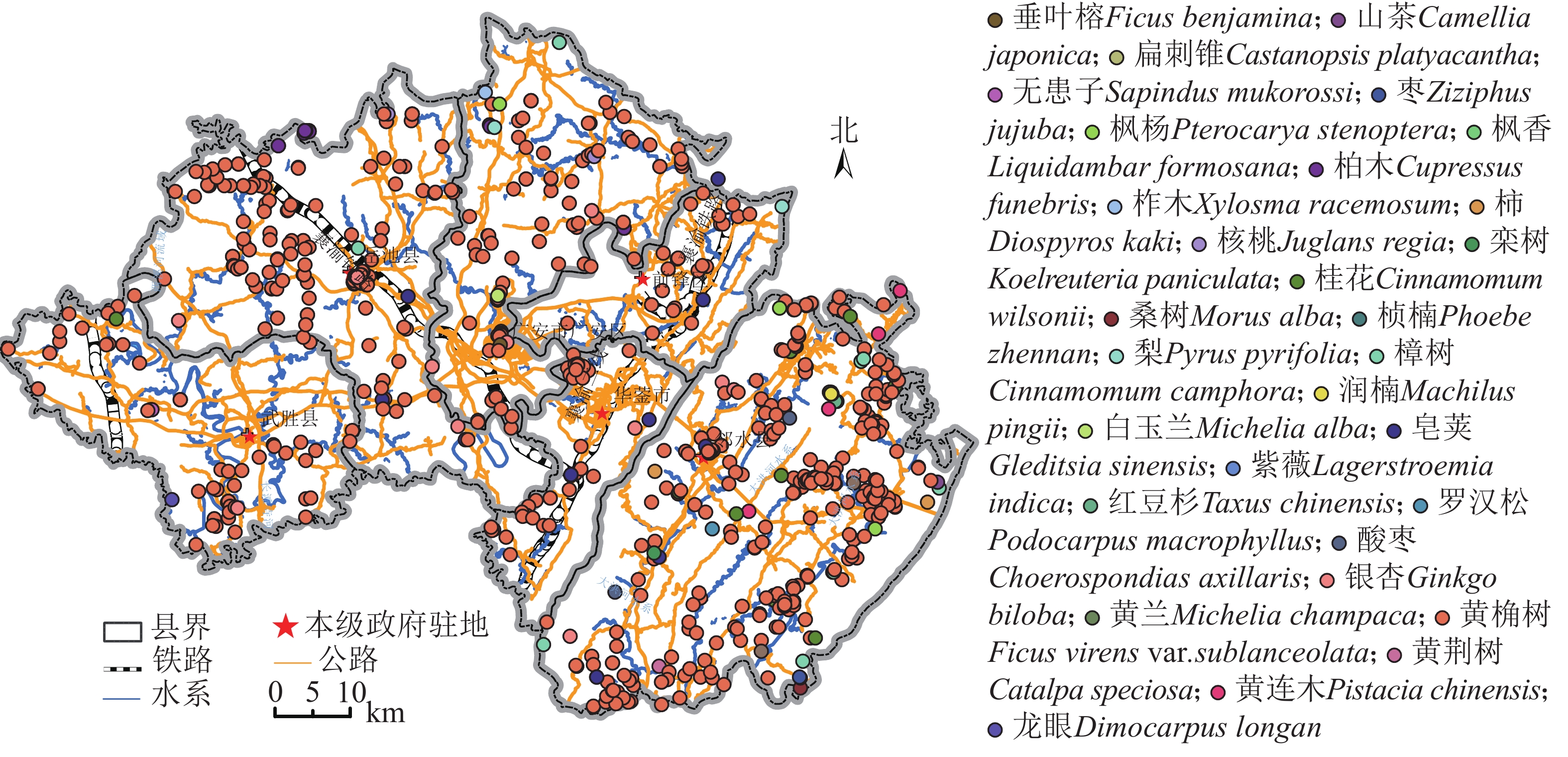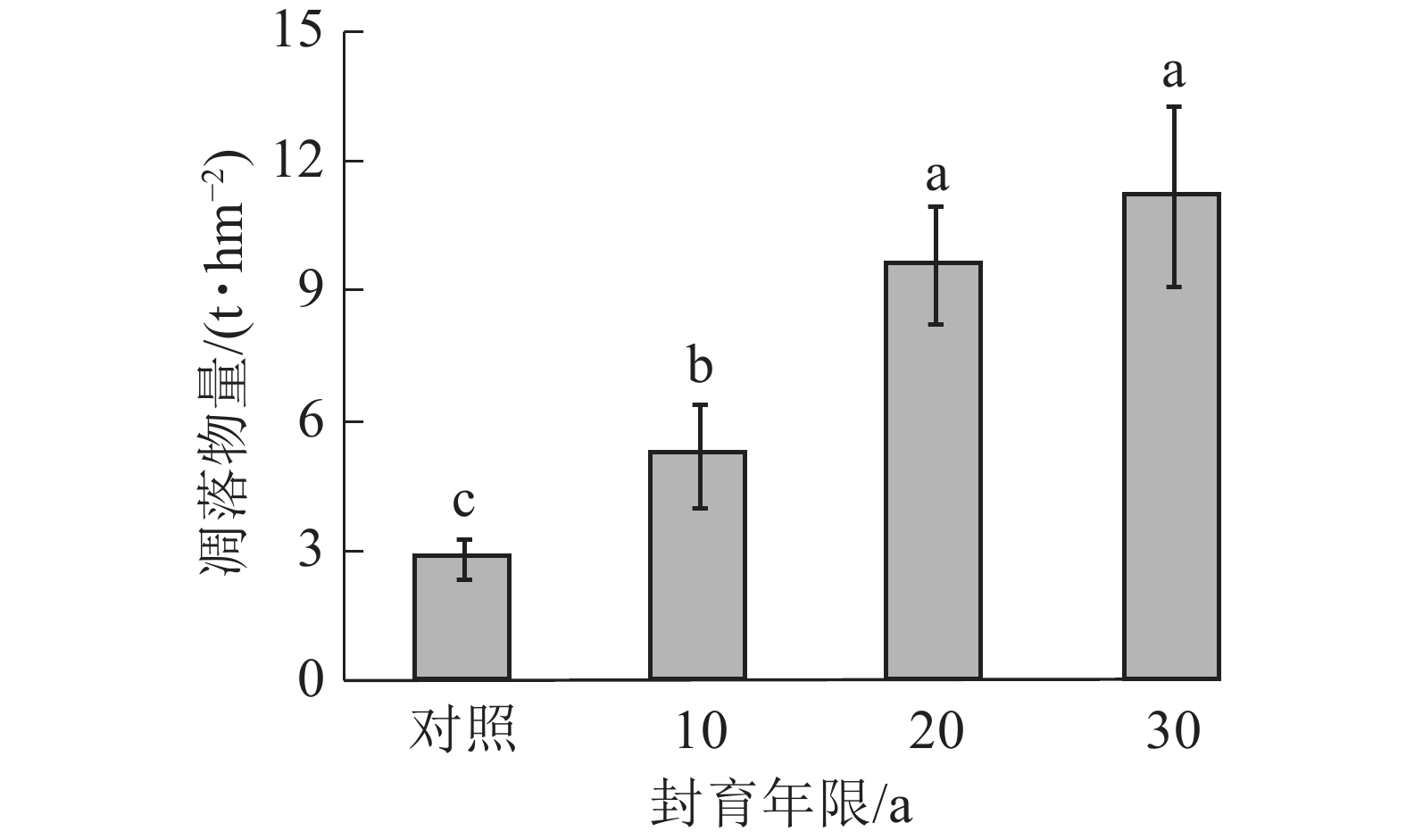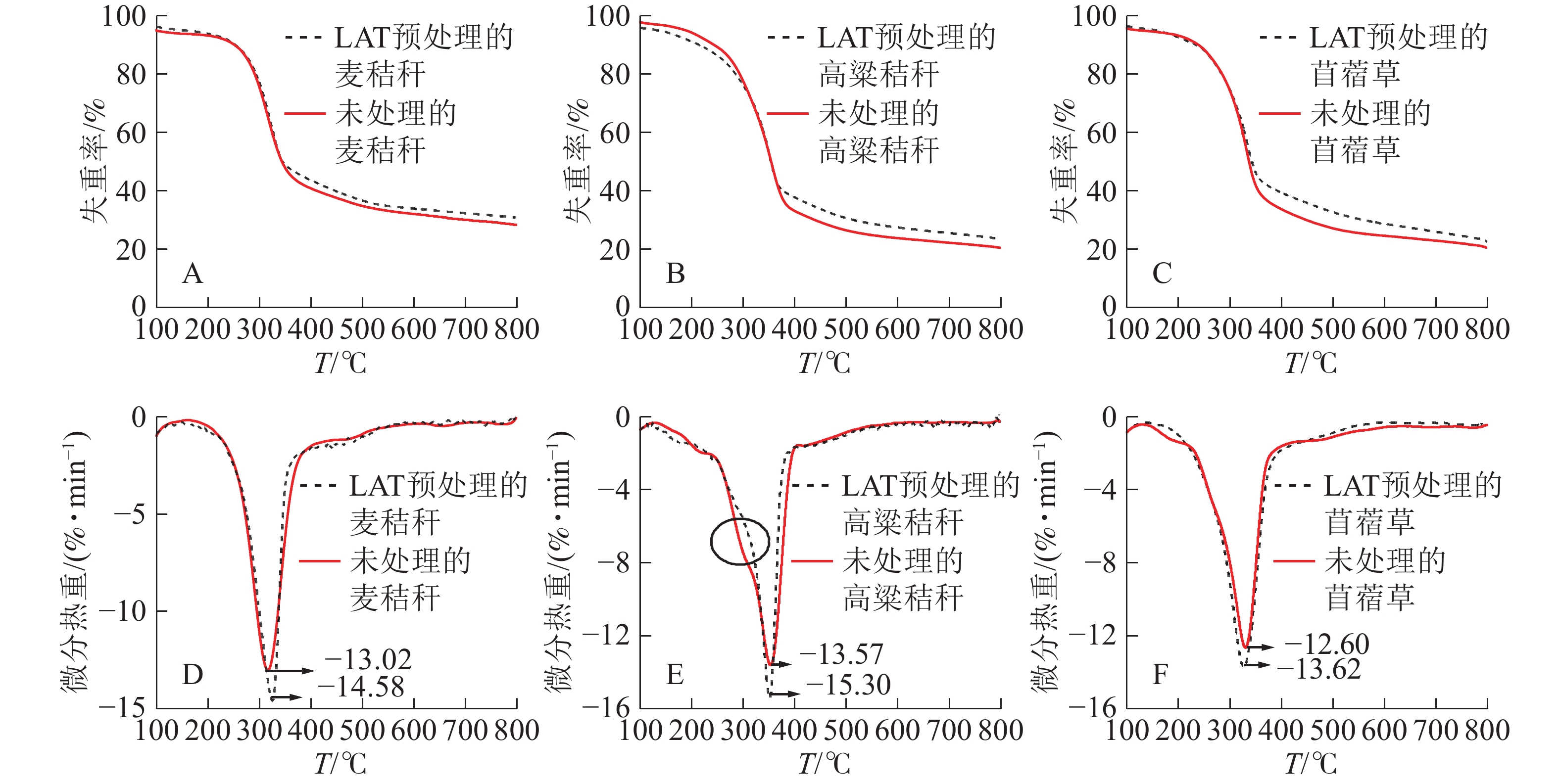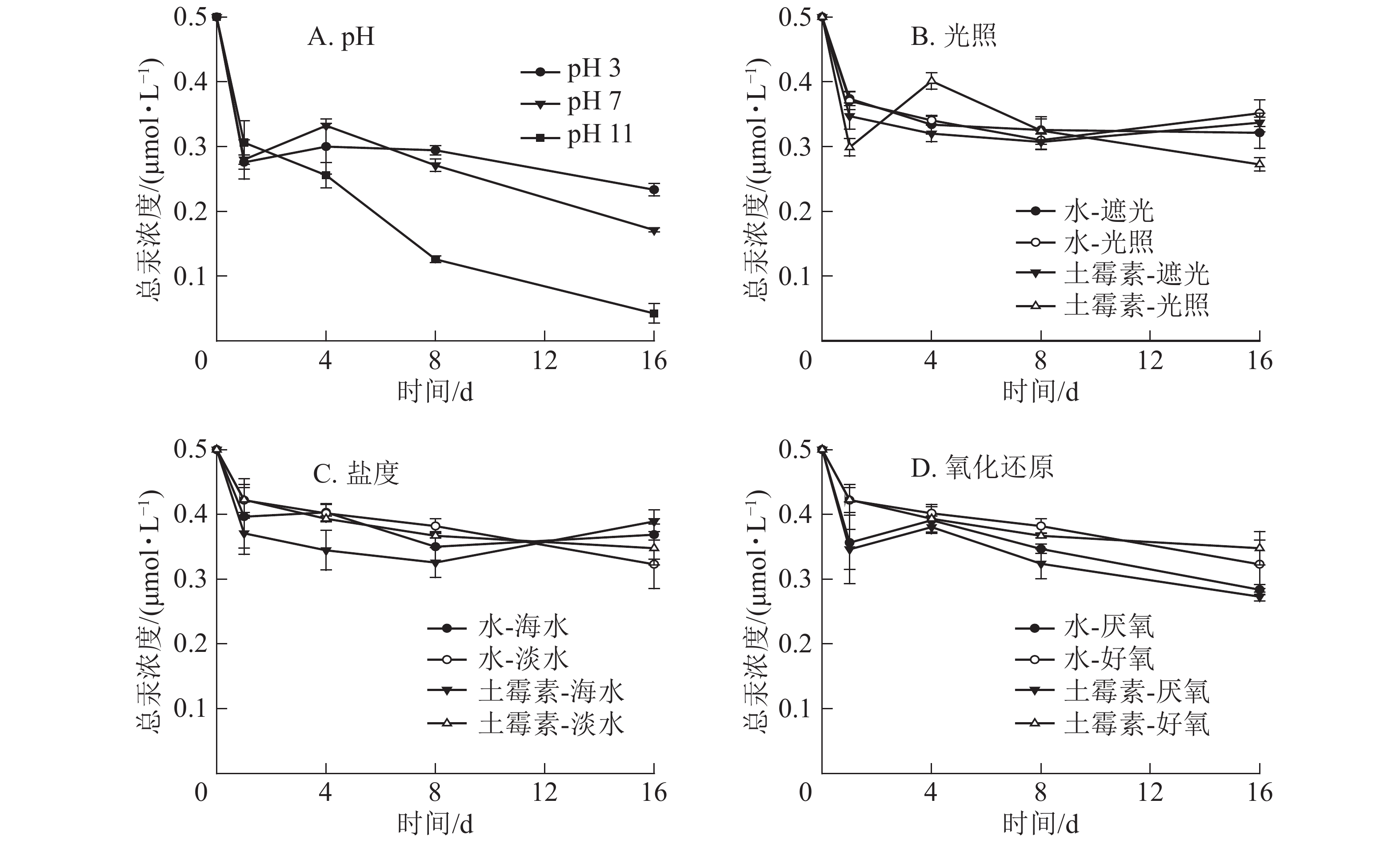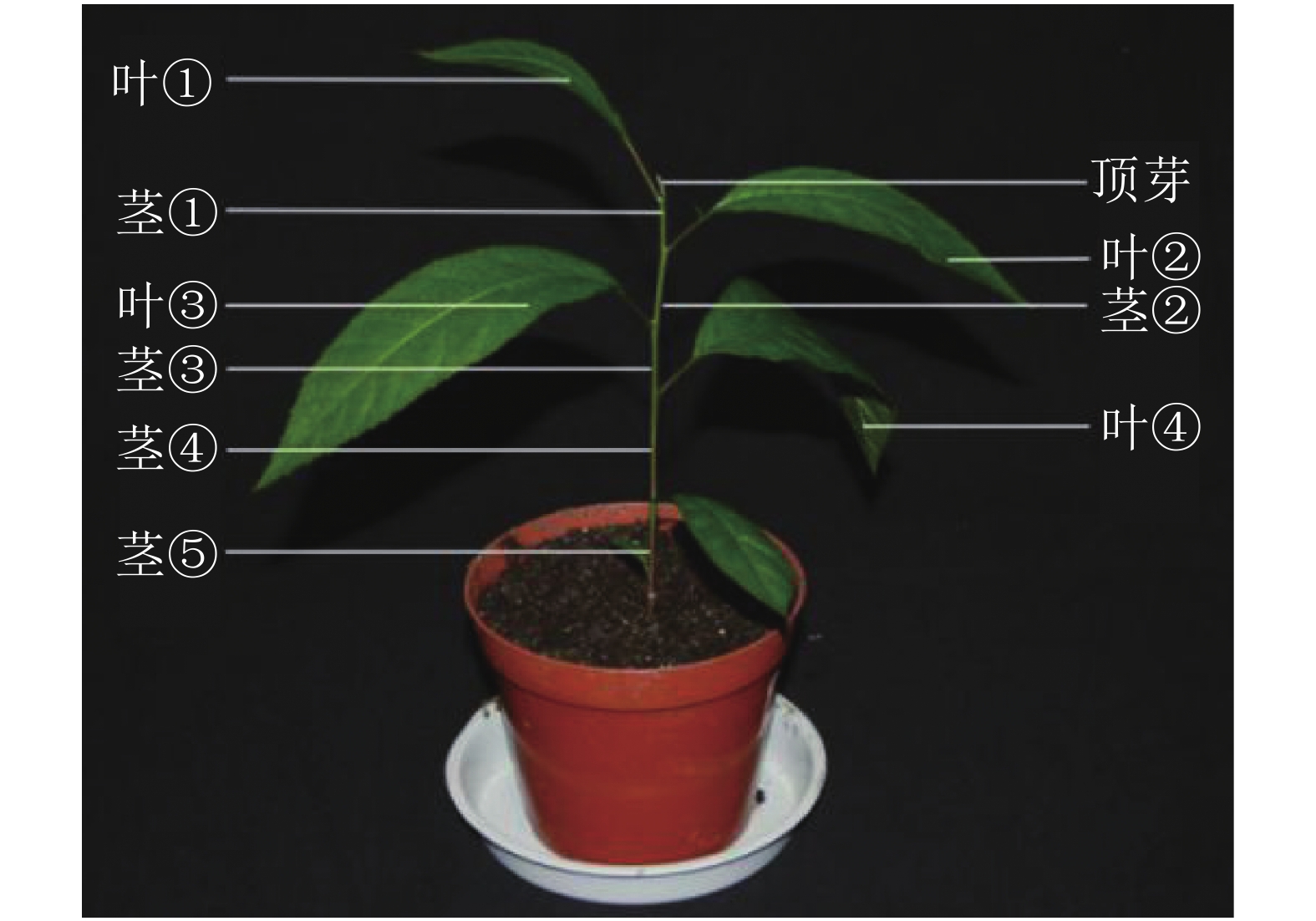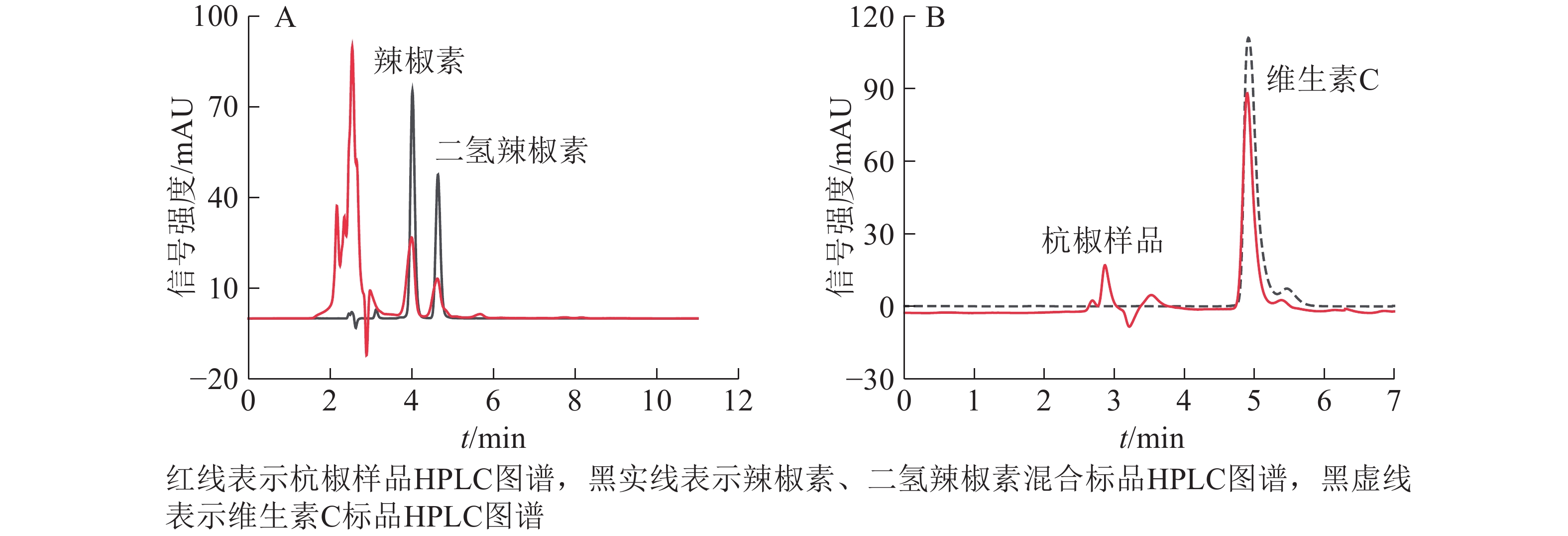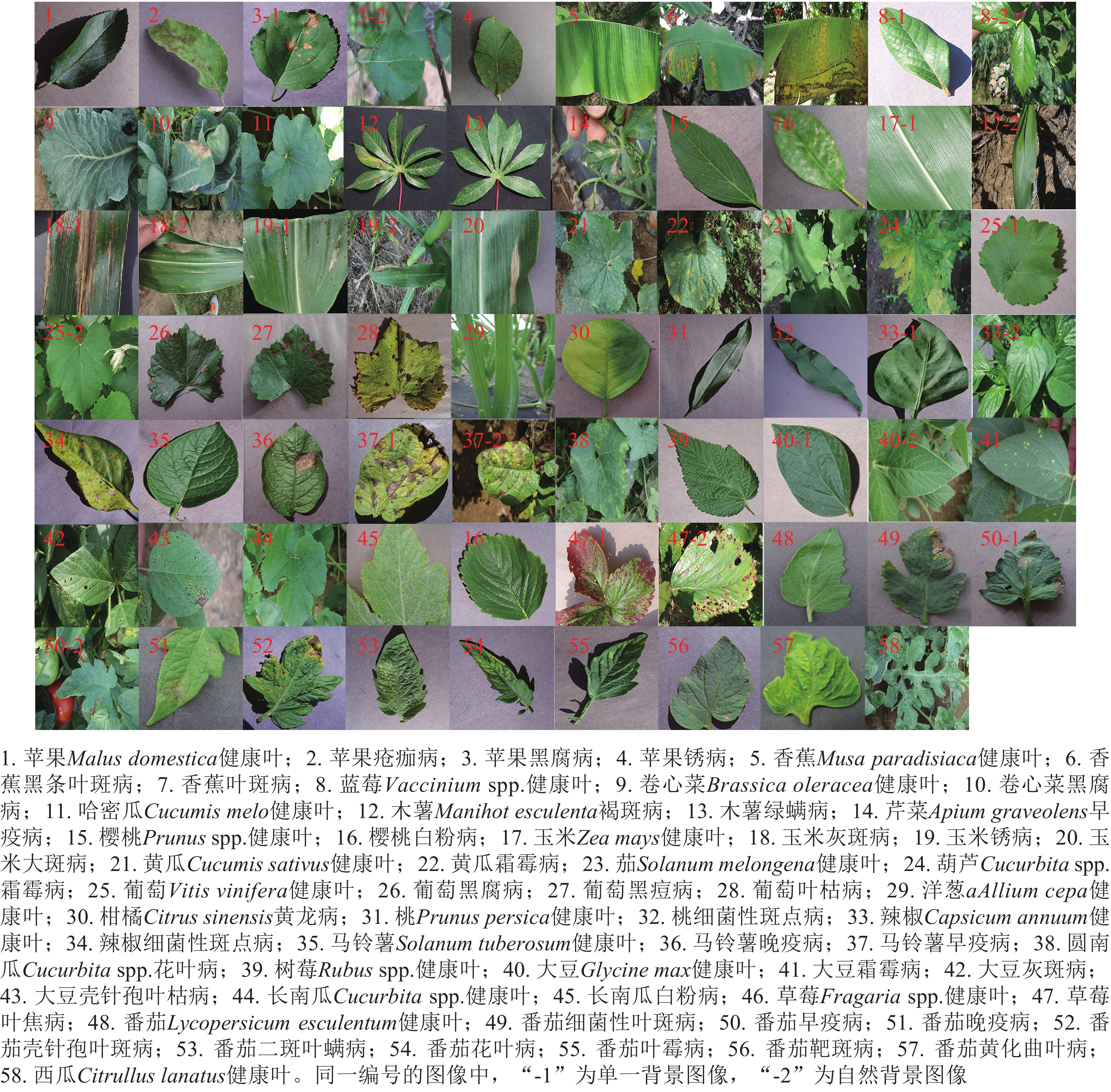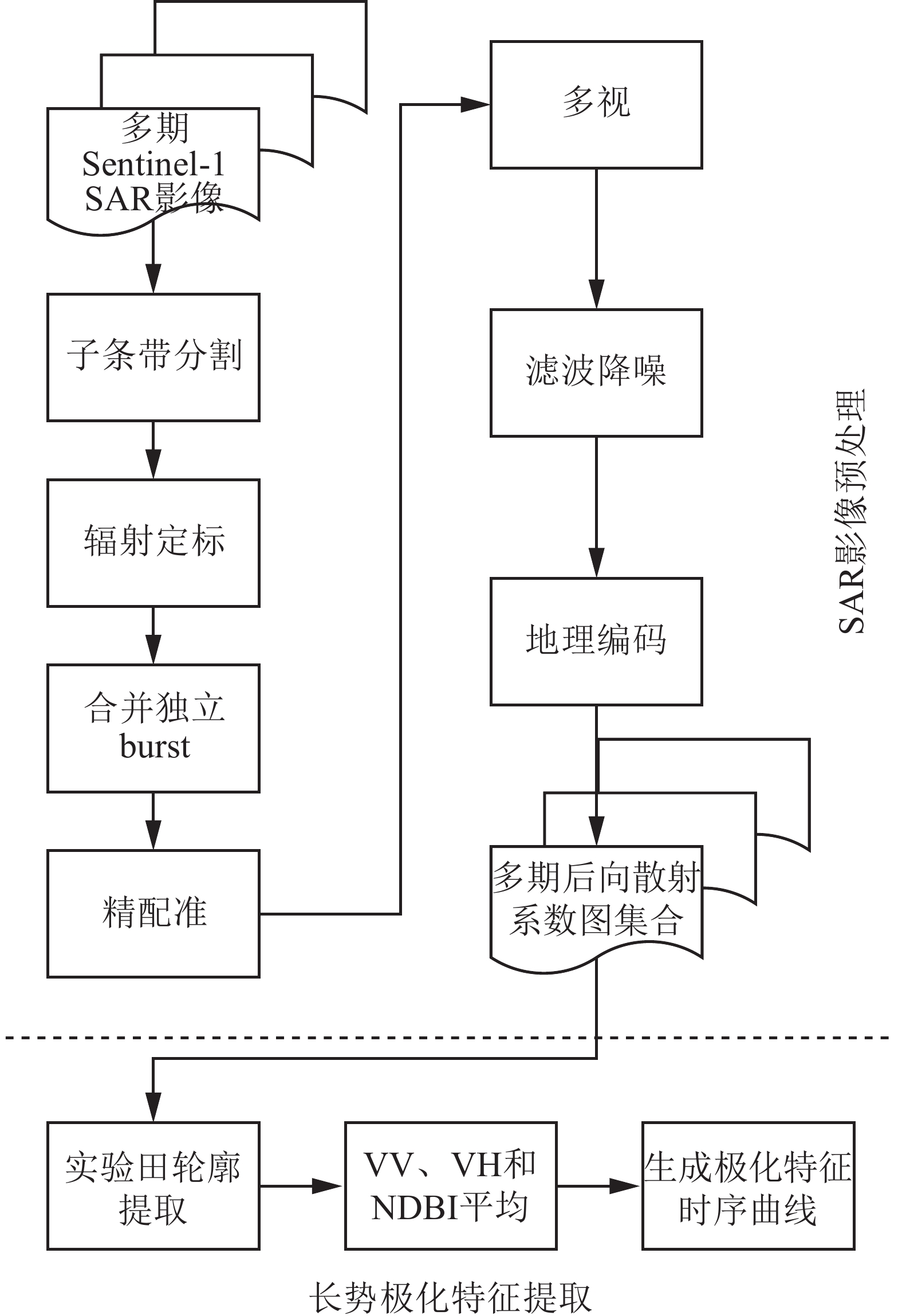2020 Vol. 37, No. 5
column
2020, 37(5): 823-832.
doi: 10.11833/j.issn.2095-0756.20190572
Abstract:
Objective The objective of this study is to find out dominant factors affecting the biomass of moso bamboo(Phyllostachys edulis) forest from site factor and stand structure factor, and to analyze the relationship between dominant factors and their effects on stand biomass. Method In 10 counties (cities) of Zhejiang Province, 52 sample plots of moso bamboo forest less disturbed by human beings were selected and the dominant factors were obtained by random forest. On this basis, the structural equation model was constructed to analyze the direct, indirect and total effects of each dominant factor on stand biomass. Result The results of random forest showed that culm density, average DBH, competition index, soil thickness and altitude were main factors affecting biomass of moso bamboo forest. The results of structural equation model analysis showed that the preset path in the model could be accepted and the collected data could be well reflected. The total effect of culm density, average DBH, competition index and soil thickness was positive, which had positive effect on the biomass of moso bamboo forest. The total effect of altitude was negative, which had negative effect on the biomass of moso bamboo forest. The total effect of average DBH was biggest, which was 0.739. The direct effect of bamboo degree on the biomass of moso bamboo forest was greater than indirect effect. The direct effect of culm density was greater than indirect effect. The indirect effect of soil thickness was biggest, reaching 0.492. Among the site factors, the total effect of soil thickness on the biomass of moso bamboo was greater than that of altitude. The indirect effect of soil thickness, altitude and competition index was greater than the direct effect. Conclusion The main component factors of moso bamboo forest, such as culm density and average DBH, are most closely related to the biomass of moso bamboo forest. Altitude, soil thickness and competition index indirectly affect the biomass of moso bamboo forest through the component factors of moso bamboo forest. In the management of moso bamboo forest, the influence of site factors, non-spatial structure, spatial structure and their interrelations on the biomass of moso bamboo forest should be considered comprehensively, and the structure of moso bamboo forest should be adjusted on the basis of making full use of the site potential in order to improve the productivity of moso bamboo forest. [Ch, 3 fig. 3 tab. 40 ref.]
2020, 37(5): 833-840.
doi: 10.11833/j.issn.2095-0756.20190651
Abstract:
Objective The calculation of annual cutting volume is the core content of forest management planning, and rational annual cutting volume can guide sustainable forest management. The traditional method of using formula to calculate annual cutting volume has such disadvantages as large deviation, strong subjectivity and obvious limitation. This study aims to solve the problems of the traditional method by using an excellent computer model. Method Based on the second-class survey data of forest resources in Jiande Forest Farm of Zhejiang Province, forest simulation and optimization system (FSOS) was used to calculate and analyze the annual cutting volume of the main cutting plan of timber forest, and the results were compared with those calculated by the formula method. Result The formula method was difficult to adapt to the complex age group structure of forest farm, and the calculation results of different formulas were quite different, while FSOS model had strong adaptability and the calculation results were accurate and feasible. FSOS results showed that the annual cutting area of timber forest was 76.35 hm2·a−1, the annual cutting volume was 9 073.51 m3·a−1, and the average cutting age was 40 years, with an average cutting volume of 109.27 m3·hm−2. In the next 50 years of simulated forest management process, the annual cutting volume would fluctuate periodically, and the structural change of the forest age group would gradually become stable. The proportion of mature and over-mature forest area at the end of the planning period would reach 40.94%, close to the ideal state. Conclusion FSOS model can adapt to complex age group structure, predict stand growth, take into account multiple objectives, combine short-term and long-term goals, comprehensively consider the economic and ecological benefits of forest farm management, and scientifically guide forest management. [Ch, 5 fig. 3 tab. 15 ref.]
2020, 37(5): 841-848.
doi: 10.11833/j.issn.2095-0756.20190585
Abstract:
Objective To better protect and preserve the ancient and famous trees in Guang’an City, this study is focused on the geographical distribution characteristics of them and the relationship between tree age, growth environment and ecological factors, which is of vital importance. Method First, the standard deviation ellipse was used to summarize the distribution characteristics of ancient and famous trees. Then, the geographically weighted regression model(GWR) and multivariable linear regression model (MLR)were employed to simulate the regression intensity of tree height, chest circumference, average crown width, altitude and slope to tree age. Result (1) The ancient and famous trees in Guang’an are distributed in a linear pattern along the water system, mountains and traffic lines while in a circular structure along the government residence and the red tourist destinations; more are distributed in the countryside than in the city with flat land as the dominant habitat; there are more normal plants than weak ones with a moderately favorable growing environment; more are distributed in the high-altitude areas than in the low-altitude areas with a significant vertical difference. (2) GWR works better than the ordinary least squares model (OLS); the average crown width, chest circumference and tree height are the key factors that affect tree age; the slope has little effect on tree age and altitude has a negative correlation with tree age. (3) The correlation coefficient of MLR is 0.297 higher than that of GWR. The coefficient intensity of each explanatory variable and regression variable is highly consistent with that of GWR, and the accuracy of estimating the age of ancient trees under 300 a is higher. Conclusion With the employment of standard deviation ellipse, geographically weighted regression model and multivariable linear regression model, the distribution characteristics of ancient and famous trees are better summarized, providing decision-making basis for the estimation of the age of ancient trees and the protection of ancient and famous trees. [Ch, 4 fig. 3 tab. 21 ref.]
2020, 37(5): 849-859.
doi: 10.11833/j.issn.2095-0756.20190647
Abstract:
Objective Soil respiration plays an important role in regulating CO2 concentration in the atmosphere. Soil respiration in the Savanna ecosystem is one of the main sources of global greenhouse gas emissions, but its emission characteristics and main influencing factors are not clear. Method Taking the Savanna ecosystem in dry hot valley of Yuanjiang inYunnan Province as an example, the soil respiration was measured from June 2014 to June 2015 by static chamber method, and the dynamic characteristics and its influencing factors in the Savanna ecosystem in Yuanjiang were studied. Result Soil temperature, soil moisture and soil respiration had obvious seasonal variations, and as expected, they were significantly (P<0.01) higher in rainy season than in dry season. The relationship between soil respiration and soil temperature and soil moisture are exponential and parabola. The temperature Q10 at 5 and 10 cm of soil was 1.73 and 1.98 respectively, which was less than the global average of 2.0. Therefore, using 10 cm soil temperature could better simulate soil respiration. Fitting analysis of soil temperature, water content and soil respiration showed that the soil respiration of Savanna ecosystem in Yuanjiang was mainly restricted by water condition. The annual emission of soil respiration in the ecosystem was 4.20 t·hm−2·a−1, including 2.71 t·hm−2 in rainy season, accounting for 64.5% of the total annual carbon emission, and 1.49 t·hm−2 in dry season, accounting for 35.5% of the total annual carbon emission. The average value of soil respiration in global Savanna ecosystem is 8.16 t·hm−2·a−1. Conclusion Compared with the global Savanna ecosystem, the total amount of soil respiration in Yuanjiang was in a lower position, which could be attributed to the lower rainfall in the Savanna ecosystem in Yuanjiang. There exists a significant positive correlation between rainfall and soil respiration in the Savanna region (R2=0.61, P<0.001). [Ch, 4 fig. 1 tab. 72 ref.]
2020, 37(5): 860-866.
doi: 10.11833/j.issn.2095-0756.20190603
Abstract:
Objective This study aims to explore the effects of natural enclosure on forest litter and soil water holding capacity of Phllostachys edulis forest and provide scientific basis for evaluating water conservation function of different types of Ph. edulis forests. Method Using the method of space-for-time, and taking Ph. edulis stands in Yuhang District, Hangzhou City of Zhejiang Province as the research object, effects of different enclosure periods (10, 20, 30 years) and conventional management (control) on water holding capacity of litter layer and soil layer of Ph. edulis forest were studied. Result Compared with ck, the litter reserves, maximum water holding capacity and effective retention capacity after natural enclosure increased by 85.7%−300.7%, 92.0%−402.8%, 87.7%−377.6%, respectively (P<0.05). After natural enclosure, the soil non-capillary porosity increased by 27.52%−137.74% (P< 0.05), the bulk density of top soil (0−30 cm) decreased by 16.53%−26.52%(P<0.05), and the water holding capacity of non-capillary pores in soil (0−60 cm) increased by 50.2%−106.3% (P<0.05). The maximum water holding capacity of surface soil (0−30 cm) after 20 years of natural enclosure increased by 18.1%−33.2% (P<0.05). Conclusion Natural enclosure can significantly improve the water holding capacity of litter and the water retention efficiency of surface soil, and the water conservation function is enhanced with the extension of enclosure period. [Ch, 4 fig. 4 tab. 25 ref.]
2020, 37(5): 867-875.
doi: 10.11833/j.issn.2095-0756.20190554
Abstract:
Objective The objective of this study is to explore the impact of tourist development on the ecological environment and to investigate the response of the secondary forest community of Schima superba to human disturbance in Mengding Mountain, Sichuan Province. Method The species diversity and soil physiochemical properties of S. superba community with mild, moderate and severe human disturbance were studied using typical plot sampling. Result (1)A total of 155 species of vascular plants were recorded in the study area, belonging to 72 families and 115 genera. (2)Human disturbance had a negative impact on the level of species diversity in the community. With the increase of disturbance intensity, the species richness index (D) , the Shannon-Wiener diversity index (H), the Simpson diversity index (H′) and the Pielou index (Jsw) of S. superba community all decreased. (3)The soil physiochemical properties varied under different disturbance intensity. Human disturbance significantly reduced soil water content, total nitrogen, total potassium, available phosphorus, and soil organic matter mass fraction (P<0.05), increased soil bulk density value, and had no significant effect on soil total phosphorus, available potassium and pH (P>0.05). (4)Correlation studies showed that soil total potassium, water content and organic matter were the most important factors affecting the species diversity of S. superba community. Conclusion The impact of human disturbance on the biodiversity and soil physiochemical properties of S. superba community is negative. [Ch, 2 fig. 4 tab. 27 ref.]
2020, 37(5): 876-882.
doi: 10.11833/j.issn.2095-0756.20190549
Abstract:
Objective The research aims to study the effects of different near-natural management measures on soil fertility under Pinus massoniana forests. Method In Kaiyang near-natural management project area of Guiyang City, the near-natural selective cutting, near-natural thinning, near-natural tending, and the control group were selected to comprehensively evaluate the impact of different management measures on soil fertility under P. massoniana forests. Result The mass fractions of organic matter, soil total nitrogen, alkali-hydrolyzed nitrogen, total potassium, total phosphorus, available phosphorus, urease, alkaline phosphatase in near-natural selective cutting were higher than those of the control group, showing an up-going trend. The mass fractions of organic matter, total nitrogen, alkali-hydrolyzed nitrogen, total potassium, total phosphorus, and available phosphorus were significantly different(P<0.05). The mass fraction of soil organic matter, total nitrogen, alkali-hydrolyzed nitrogen, total potassium, available potassium, total phosphorus, available phosphorus, and sucrose in near-natural thinning was higher than that in the control group, showing an increasing trend, among which the mass fraction of total nitrogen, alkali-hydrolyzed nitrogen, total potassium, available potassium, total phosphorus and available phosphorus had significant differences (P<0.05), but the mass fraction of urease showed a decreasing trend. The mass fraction of alkali-hydrolyzed nitrogen, total potassium, available phosphorus and urease in near-natural tending showed a decreasing trend, among which the difference between alkali-hydrolyzed nitrogen and total potassium was significant (P<0.05), and the mass fraction of sucrose showed an increasing trend. The comprehensive evaluation scores of soil fertility in the P. massoniana stands with near-natural thinning and selective cutting were significantly different from those of the control group (P<0.05), but the difference in tending was not significant (P>0.05). The effect of different near-natural management measures on soil physical indexes was not significant (P>0.05). Conclusion Near-natural thinning and selective cutting can significantly promote soil fertility of P. massoniana forests, which is of great significance for maintenance and improvement of soil fertility of P. massoniana forests. The effect of near-natural tending on forest stands is not significant. The near-natural management theory plays an important role in improving forest soil fertility and sustainable forest management in Guiyang. [Ch, 1 fig. 6 tab. 19 ref.]
2020, 37(5): 883-890.
doi: 10.11833/j.issn.2095-0756.20190583
Abstract:
Objective As phytolith-occluded organic carbon (PhytOC) plays a unique role in the reduction of atmospheric CO2 contents and the mitigation of the greenhouse effect, this study, with a comparison conducted of the PhytOC sequestration potential of masson pines( Pinus massoniana) of different provenances is aimed at the selection of the Masson pine with the highest PhytOC sequestration capacity. Method With masson pines of twenty provenances(twenty regions in 11 provinces ) chosen at Laoshan Forest Farm which is located in Chun’an County of Zhejiang Province, an analysis was conducted of the contents of total OC, phytoliths, PhytOC as well as the trunk biomass of masson pines to highlight the differences of sequestration potential of masson pines of different provenances. Result (1) The contents of total OC, phytoliths, PhytOC, and phytolith carbon mass fraction in the trunks of masson pines were in the range of 467.6−489.6, 0.305−0.845, 126.8−210.2, and 0.049−0.128 g·kg−1 respectively. (2) The trunk biomass and PhytOC stock in the trunks of masson pines were 76.48−295.39 kg·plant−1 and 4.83−31.58 g·plant−1, respectively. (3) As was shown in the cluster analysis, the chosen masson pines of 20 provenances can be divided into four categories: a. Hubei Tongshan 84, Guangxi Gongcheng 111, Jiangxi Jian 63 and Guangxi Cenxi 115 which demonstrate the strongest PhytOC sequestration capacity; b. 7 provenances including Henan Tongbai 21, Hunan Anhua 72 and Guangdong Xinyi 105 which demonstrate relatively strong PhytOC sequestration capacity; c. 8 provenances including Zhejiang Chun’an 56, Guizhou Duyun 123, Fujian Yongding 95; d. Zhejiang Qingyuan 54 which demonstrate the weakest PhytOC sequestration capacity. Conclusion Significant differences were shown in the content of phytoliths, PhytOC, and carbon content of phytolith in the trunks of masson pines of different provenances (P<0.05). Guangxi Cenxi 115 demonstrated the highest PhytOC sequestration capacity and should be promoted in plantation in the ecosystem of masson pines so as to increase the sequestration amount of PhytOC. [Ch, 3 fig. 2 tab. 35 ref.]
2020, 37(5): 891-897.
doi: 10.11833/j.issn.2095-0756.20190573
Abstract:
Objective The multi-functional ecological services provided by Wuyanling National Nature Reserve play a vital role in protecting and improving the ecological environment of Taishun and Wenzhou. Method Taking Wuyanling National Nature Reserve as the research area, the quality and value of the ecological services of the forest ecosystem in Wuyanling National Nature Reserve were quantitatively evaluated with reference to the Forest Ecosystem Assessment Standard (LY/T 1721−2008). Result The total value of forest ecosystem ecological services in Wuyanling National Nature Reserve in 2017 was 100.24 ×108 yuan·a−1, and the value of forest ecological service per unit area was 3.92×105 yuan·hm−2·a−1. The proportion of forest ecosystem service value from large to small in Wuyanling National Nature Reserve was soil conservation, water conservation, accumulation of nutrients, carbon fixation and oxygen release, biodiversity protection, and purification of the atmospheric environment. It could be seen that conservation soil, water conservation and accumulation of nutrients were the main services of Wuyanling forest ecosystem, and the sum of the three accounted for 91.92%, occupying a dominant position. The service value of different forest types in Wuyanling National Nature Reserve ranging from large to small was evergreen broad-leaved forest, Chinese fir forest, bamboo forest, Masson pine forest, coniferous and broad-leaved mixed forest, cedar forest, and economic forest. The evergreen broad-leaved forest contributed more than 50% to Wuyanling forest ecosystem service value, occupying an absolute position. Conclusion The ecological service value per unit area of evergreen broad-leaved forest in Wuyanling National Nature Reserve is much higher than that of other forest types. Therefore, through forest facies transformation technologies such as transforming coniferous forest into broad-leaved forest, the quality of forest stands can be improved, the structure of ecosystems can be optimized, and the output and value of ecosystem services can be increased. [Ch, 5 tab. 27 ref.]
2020, 37(5): 898-906.
doi: 10.11833/j.issn.2095-0756.20190575
Abstract:
Objective This study aims to investigate the effects of liquid ammonia treatment (LAT) pretreatment on the hydrolysis resistance of biomass and the enzymatic hydrolysis rate of lignocellulosic biomass. Method Four different types of lignocelluloses biomass, namely wheat straw (Triticum aestivum), alfalfa (Lotus corniculatus), sorghum straw (Sorghum bicolor), and their mixture (mass ratio 1∶1∶1), were pretreated by LAT method, and the effect of LAT on their chemical structure changes was studied by using thermo gravimetric analysis (TGA), Fourier transform infrared spectrometer (FTIR), X-ray diffractometer (XRD), and scanning electron microscope (SEM). Then, the effect of pretreatment temperature and enzymatic hydrolysis time on the enzymatic hydrolysis conversion rates of glucan and xylan in the four raw materials was investigated. Result LAT had a significant effect on the chemical structure of biomass materials. After this pretreatment, the relative content of glucan, xylan, and arabinan in four types of lignocelluloses biomass slightly decreased. The relative content of O and H decreased because some functional groups containing O and H dropped off. The crystallinity decreased slightly, while the surface pore structure significantly increased, and the availability of enzymes in the chemical structure of biomass increased. The optimum pretreatment temperature of wheat straw and mixture was 90 ℃, while that of alfalfa and sorghum straw was 110 ℃. The enzymatic hydrolysis rates of glucan and xylan increased with the increase of enzymatic hydrolysis time. Among the four types of lignocelluloses biomass, the highest enzymatic hydrolysis rate of glucan obtained at the optimal enzymatic hydrolysis condition was wheat straw, followed by the mixture, sorghum straw, and alfalfa. The enzymatic hydrolysis rate of xylan ranging from large to small was sorghum straw, wheat straw, the mixture, and alfalfa. Conclusion LAT can improve the enzymatic hydrolysis efficiency of lignocellulosic biomass, especially that of wheat straw and sorghum straw. [Ch, 8 fig. 2 tab. 24 ref.]
2020, 37(5): 907-913.
doi: 10.11833/j.issn.2095-0756.20190568
Abstract:
Objective To better understand the combined pollution of antibiotics and mercury, an investigation is conducted of the influence of different environmental factors on the dissolved gases mercury (DGM) formed in the liquid phase after the complexion reaction of oxytetracycline (OTC) with mercury. Method With OTC solution (1 μmol·L−1) and mercury chloride (HgCl2 1 μmol·L−1) selected as materials, simulation experiments were conducted in the laboratory with pH, light, salinity, and redox employed as the environmental factors to explore the changing characteristics of DGM concentration after the reaction. Result Environmental factors have significant impact on the formation of DGM. There is a significant decrease in DGM concentration with the increase of pH. The DGM concentration in the condition of light irradiation was slightly higher than that in the dark condition. The DGM concentration in sea water was significantly higher than that in freshwater. The DGM concentration in anaerobic condition was slightly lower than that in aerobic condition but the situation was reversed after ten days. Conclusion The complexation reaction of OTC with mercury occurs and is beneficial to the formation of DGM which is subject to the impact of different environmental factors. The DGM formed by the reaction of OTC and Hg is higher than that in the control group. However, the influence of OTC on the formation of DGM is not as strong as the environmental factors. [Ch, 3 fig. 27 ref.]
2020, 37(5): 914-921.
doi: 10.11833/j.issn.2095-0756.20190587
Abstract:
Objective This study aims to optimize the culture conditions of Cd-tolerant Pseudomonas TCd-1 based on response surface methodology. Method Taking the basic fermentation conditions as the control, and the absorbance D(660) value of the strain as the evaluation index, the single factor test was carried out to determine the best carbon source, nitrogen source, and inorganic salt species of the culture medium components. The Plackett-Burman test design was used to evaluate the influence of 8 factors on the growth of the strain, including beef extract, yeast powder, magnesium chloride, culture temperature, initial pH, inoculation quantity, culture time, and rotation speed. The best combination of significant factors was obtained by the steepest climbing test. The culture conditions of TCd-1 were optimized by combining the box Behnken design test and response surface analysis. Result The best carbon source, nitrogen source, and inorganic salt of the strain culture medium components were beef extract, yeast powder, and magnesium chloride. The significant factors affecting the growth of the strain were yeast powder, culture temperature, and initial pH. The optimized culture conditions based on response surface methodology included beef extract 0.5%, yeast powder 1.0%, magnesium chloride 0.5%, pH 6.3, temperature 33 ℃, inoculation rate 1.25%, rotation speed 160 r·min−1, and culture time 24 h. Conclusion According to the optimal conditions, the D(660) value of the optimized bacterial solution is 67.07% higher than that of the control after repeated experiments, which is consistent with the predicted value of the model, indicating that the optimized conditions could significantly promote the growth of the strain and achieve the desired goal.[Ch, 1 fig. 6 tab. 26 ref.]
2020, 37(5): 922-929.
doi: 10.11833/j.issn.2095-0756.20190566
Abstract:
Objective This study attempts to explore the effect of gibberellin(GA3) on plant height and discuss the feedback regulation mechanism of GA20ox, GA3ox and GA2ox in the process of GA3 synthesis. Method The leaves of Carya illinoensis seedlings were sprayed with 100 mg·L−1 GA3. The plant height, internode length and main root length of C. illinoensis and the spatiotemporal variation of CiGA20ox, CiGA3ox and CiGA2ox were studied. Result After 28 days of GA3 application, the internode length and the elongation of the main root length of C. illinoensis seedlings were significantly different from those of the control(P<0.05), but the number of internodes did not change. The average plant growth was 2.9 cm, which was 1.93 times that of the control, and the difference was extremely significant (P<0.01). The results of real-time PCR showed that there were spatial-temporal differences in the expression of GA20ox, GA3ox and GA2ox during the growth period of C. illinoensis. Exogenous GA3 could continuously reduce the expression of CiGA20ox. After 28 days, the expression level of CiGA20ox was only 38.6% of the initial value. The expression level of CiGA3ox dropped to a low point of 55.4% of the initial value on day 7 and rose to 350% of the initial value on day 28. The expression level of CiGA2ox in general showed a wavy change, reaching the peak after 7 days, then falling back to the initial level after 21 days, and rising to 220% of the initial value after 28 days. However, CiGA3ox accumulated in the stem of C. illinoensis seedlings, which changed in transcription level compared with CiGA20ox and CiGA2ox. Conclusion The exogenous GA3 could promote the stem elongation of C. illinoensis and cause the temporal and spatial variation of the key gene expression patterns of GA3 metabolism in C. illinoensis. [Ch, 6 fig. 1 tab. 29 ref.]
2020, 37(5): 930-938.
doi: 10.11833/j.issn.2095-0756.20190614
Abstract:
Objective The objective of this study is to further analyze the genetic diversity, genetic relationship and parental identification of Hippeastrum rutilum cultivars at molecular level. Method The SCoT marker system of H. rutilum was screened by orthogonal design method, and genetic diversity and genetic relationship of 41 cultivars were analyzed. Result (1) The optimum reaction system of SCoT markers for H. rutilum (20 μL) included DNA 40 ng, primer 0.1 μmol·L−1, MgCl2 2.0 mmol·L−1, dNTPs 0.4 mmol·L−1 and rTaq DNA polymerase 0.75 U (1 U=16.67 nkat). (2) 77 polymorphic bands were obtained from 41 H. rutilum cultivars by 12 SCoT primers, and the average polymorphic band ratio was up to 86.52%. The genetic similarity coefficient between H. rutilum cultivars was 0.292 3−0.834 3, indicating that the 41 cultivars had high genetic diversity and wide genetic range. (3)UPGMA(unweighted pair-group method with arithmetic means) cluster analysis showed that the SCoT marker clustering of H. rutilum had significant correlation with flower color, but not with the petal type. At genetic similarity coefficient of 0.420 0, the 41 cultivars were divided into two groups. The first group had both double and single petal cultivars. The first group was divided into four subgroups, among which those with similar flower colors were clustered into one group. In subgroupⅠd, the single-petal, white ‘Hydrangea’ (No. 20) and red ‘Miracle’ (No. 22) were the possible parents of double-petal, orange-red and white multicolor flowers (No. 21 ‘Yingchun’). The second group was mostly multicolor flowers. Conclusion SCoT marker technique can be effectively applied to genetic diversity analysis and identification of possible parents of H. rutilum cultivars. [Ch, 6 fig. 4 tab. 21 ref.]
2020, 37(5): 939-949.
doi: 10.11833/j.issn.2095-0756.20190619
Abstract:
Objective This paper is aimed to explore the phenotypic and diversity of ornamental pomegranate and provide theoretical basis for the identification and evaluation of ornamental pomegranate resources in China. Method With 24 ornamental pomegranate cultivars selected, an investigation was conducted of their 13 ornamental features such as plant form, branch type, flower color, flower size, number of petal and number of petaloid stamens with an analysis of the diversity. Then, based on these indexes, principal component analysis and cluster analysis were carried out, while the ploidy and C-value of 24 cultivars were determined by flow cytometry(FCM). Result (1) The ornamental pomegranate varieties were rich in phenotypic diversity, the morphological diversity index of quantitative trait (1.715) was greater than that of qualitative trait (1.148), and the coefficient of variation of the number of petaloid stamens and petals was 117.59% and 78.86%, respectively, indicating that the increasing number of petals and stamen petalization were the breeding directions of ornamental pomegranate. (2) The variation trend of diversity index of petalized stamen number and petal number was not consistent with that of the variation coefficient, implying that the variation range was large and the variation distribution was uneven. (3) The characteristic values of the first four principal components were greater than 1.00, and the cumulative contribution rate reached 80.10% while the shape and color of branches, flower size, petal number, petal formation, plant form and flower color were the main factors affecting the phenotype differences of ornamental pomegranate. (4) The 24 ornamental pomegranate cultivars could be divided into three groups with their genetic clustering closely related to flower pattern, color and plant type: orange flower cultivars were much more closely related to pink and white flower cultivars than multicolor flower cultivars and single petal cultivars were closely related to all double petal cultivars and most double petal cultivars, while a small number of double petal cultivars were closely related to proliferation flower cultivars, which was consistent with the mainstream view of flower type evolution. (5) All ornamental pomegranate cultivars were diploids, indicating that pomegranate cultivars were genetically stable. Conclusion The phenotypic diversity in ornamental pomegranate was rich, and all the tested cultivars were diploid. [Ch, 1 fig. 8 tab. 48 ref.]
2020, 37(5): 950-956.
doi: 10.11833/j.issn.2095-0756.20190577
Abstract:
Objective This study is aimed to determine the dynamic changes of capsaicinoids, vitamin C and dry matter contents in the fruit of Hangzhou pepper (Capsicum annuum ‘Hangzhou Jizhua’בJilin Zaojiao’) during the harvest period. Method Contents of capsaicin, dihydrocapsaicin, vitamin C and dry matter in the fruit of four common cultivars of Hangzhou pepper harvested at different times (14, 21, 28, 35, 42, 49, 56 days after flowering) were measured by HPLC. Result Content of capsaicinoids fluctuated during the harvest period and varied among four cultivars, while the contents of vitamin C and dry matter increased with fruit ripening. Conclusion Around 49 days after flowering is the best pepper harvest time in terms of fruit maturity, and the contents of capsaicinoids, vitamin C and dry matter. Since the dynamic changes of capsaicinoids content varied among cultivars, the optimum harvesting planning should take into consideration various factors such as pepper varieties, market demand and supply-demand relationship. [Ch, 4 fig. 3 tab. 27 ref.]
2020, 37(5): 957-962.
doi: 10.11833/j.issn.2095-0756.20190604
Abstract:
Objective To provide a theoretical basis for solving salt damage of rose, the effect of exogenous melatonin (MT) on the physiological characteristics of rose seedlings (Rosa chinensis ‘Old Blush’) with the NaCl stress was investigated. Method 90 d rose cutting seedlings were watered with 0, 5, 10 and 20 μmol·L−1 melatonin of exogenous melatonin solution respectively for 5 days before they were treated with 20 d 200 mmol·L−1 NaCl while the control group was treated with water to study the alleviation of exogenous melatonin on rose seedlings under salt stress with the physiological and biochemical indexes determined after the salt treatment. Result With the exposure to salt stress, rose seedlings with the alleviation of exogenous melatonin of different concentrations present a significant decrease in electrical conductivity and mass molar concentration of malondialdehyde(P<0.05) while a significant increase in the content of soluble protein, proline and ascorbic acid (P<0.05). In particular, the activity of superoxide dismutase(SOD), catalase(CAT) and peroxidase(POD)(P<0.05)has been significantly promoted, which helps enhance the scavenging activity of reactive oxygen species(ROS) under salt stress. Conclusion The exogenous melatonin treatment could enhance the activity of antioxidant enzymes and increase the osmotic substance content to avoid lipid peroxidation and improve rose salt tolerant ability. [Ch, 3 fig. 21 ref.]
2020, 37(5): 963-970.
doi: 10.11833/j.issn.2095-0756.20190612
Abstract:
Objective Comparing the combustibility of fresh bamboo leaves in gardens, in order to protect bamboo forest. Method Taking 5 common flammable woody plants as control, the moisture content, mass per unit area, absolute line rate, absolute area loss rate, absolute mass loss rate, relative line rate, relative area loss rate and relative mass loss rate of 17 species’ fresh bamboo leaves in Kunming were measured and calculated. The combustibility of bamboo leaves was evaluated by factor analysis and systematic clustering. Result All the fresh bamboo leaves of 17 species were inflammable, and the order of combustibility from large to small was as follows: Neosinocalamus affinis, Bambusa ventricosa, Fargesia yuanjiangensis, Schizostachyum funghomii, B. sinospinosa, B. textilis, B. multiplex, Dendrocalamus semiscandens, Chimonocalamus pallens, Phyllostachys nigra var. henonis, B. distegia, Ph. nigra, D. bambusoides, D. hamiltonii, D. giganteus, B. intermedia, B. surrecta. Conclusion 10 of them were highly flammable and 7 were relatively flammable. [Ch, 1 fig. 6 tab. 25 ref.]
2020, 37(5): 971-977.
doi: 10.11833/j.issn.2095-0756.20190624
Abstract:
Objective This study aims to understand the nutritional content in larva feces of Heterolocha jinyinhuaphaga, and evaluate its nutritional value. Method By using national standard test method, the nutritional content in larva feces of H. jinyinhuaphaga were determined, and the amino acid content, index of essential amino acid (IEAA), ratio of essential amino acid to nonessential amino acid, and ratio of unsaturated fatty acid to saturated fatty acid(P/S) in larva feces of H. jinyinhuaphaga were analyzed and compared with those of common insect tea. Result The contents of water, total sugar, crude fat, and protein in larva feces were 10.08%, 2.40%, 2.73%, and 11.89%, respectively. Total amino acid content was 4.326 9 mg·g–1, and total content of essential amino acid was 1.666 2 mg·g–1. The proportion of essential amino acid to total amino acid was 38.51%, and the ratio of essential amino acid to nonessential amino acid was 62.62%. IEAA was 1.20. The mass fraction of unsaturated fatty acid was 64.05% and the ratio of unsaturated fatty acid to saturated fatty acid was 1.78. The essential fatty content was 30.49%. The contents of Ca, K, and Mg were higher, 8.126 7, 4.955 6, and 3.257 3 mg·g–1 respectively, while the content of Cu was the lowest, 0.053 8 mg·g–1. The contents of Vitamin C and Vitamin E were 0.387 5 and 0.158 3 mg·g–1. Conclusion The larva feces of H. jinyinhuaphaga are rich in nutrients and suitable for development and utilization as a new resource for insect tea. [Ch, 5 tab. 22 ref.]
2020, 37(5): 978-985.
doi: 10.11833/j.issn.2095-0756.20190595
Abstract:
Objective The traditional deep learning model is not suitable for edge deployment because of too many parameters and too much calculation. Automatic identification of plant diseases on the edge of the network is urgently needed to realize long-term and large-scale low-cost crop monitoring. Method By using multiple model compression methods, a light weight deep convolution neural network was obtained, which could be deployed in the embedded system with limited computing power to realize intelligent identification of plant diseases at edge nodes. The model compression was divided into two stages. The first stage used the channel pruning method based on L1 norm to compress the MobileNet model. In the second stage, simulation learning and quantization were combined to restore the recognition accuracy while the model was quantized, and a high-precision lightweight end model was obtained. Result Experimental results of 58 kinds of plant diseases in PlantVillage dataset showed that channel pruning compressed MobileNet by 3.6−14.3 times, and quantization reduced the parameter accuracy of the model from 32 bit to 8 bit. The overall compress rate reached 14.4−57.2 times, and the recognition accuracy was only reduced by 0.24% to 1.65%. Compared with the pruning method trained by common learning, and pruning with quantization trained by common learning, this method achieved higher compression rate and recognition accuracy. Conclusion The combination of multiple model compression methods can compress the artificial intelligence models in depth with only tiny loss of accuracy, and provide plant disease recognition models for agriculture and forestry based on edge computing. [Ch, 3 fig. 2 tab. 23 ref.]
2020, 37(5): 986-991.
doi: 10.11833/j.issn.2095-0756.20190622
Abstract:
Objective With the optimization of tower layout and time sequence in the process of construction, this paper is aimed at the promotion of the construction efficiency of tower networks in forest regions. Method With one forest farm in the suburbs of Beijing chosen as the testing spot and features of watchtower network construction such as spatiality, periodicity and dynamicity taken into consideration, efforts were made to figure out a near-optimal layout design built employing Greedy algorithm on the basis of Maximum monitoring area model(Max-MAM) established with the vertex method. Meanwhile, with such a design, on the basis of DAMACSTM which was built employing the dynamic multi-attribute entropy weight method, the optimal time sequence of construction was figured out. Result 38 optional points extracted adopting the vertex method, with the optimal layout achieved by Max-MAM, \begin{document}$ {\overline {P}_6} = \left\{ {{a_6},{a_{29}},{a_{36}},{a_{12}},{a_{26}},{a_{18}}} \right\}$\end{document} ![]()
![]()
Conclusion Two models of Max-MAM and DMACTSM proposed in this paper, can adjust and figure out the optimal time sequence of construction and when combined with GIS, are conducive to the achievement of the optimal layout of watchtower networks. And the optimal time sequence of construction helps maximize the comprehensive benefits in aspects like the increase in the monitoring area, the traffic, the slope, and existing structures. [Ch, 6 fig. 3 tab. 16 ref.]
2020, 37(5): 992-998.
doi: 10.11833/j.issn.2095-0756.20190605
Abstract:
Objective The method of directly using synthetic aperture radar (SAR) backscatter coefficient to monitor the growth trend of Oryza sativa and other crops in south China is susceptible to rainfall and prone to produce large fluctuations on the time series curve. The objective of this study is to explore methods to reduce this impact and obtain more accurate results reflecting the law of O. sativa growth. Method Taking the O. sativa planting area in Guiping City of Guangxi as sample area, the temporal characteristics of VV and VH-polarized backscattering coefficient of O. sativa growth under the influence of rainfall were analyzed using Sentinel-1 dual-polarization SAR data of 23 periods from March to November 2018 and the corresponding rainfall data. On this basis, an improved method named “Normalized Differential Backward Scattering Index (NDBI)” based on the combination of VV and VH-polarized backscatter coefficients was proposed and the results were verified by optical satellite image data. Result The mean curvature of the NDBI curve was 0.86, which was lower than that of VV and VH curves (2.90 and 2.31, respectively), indicating that the NDBI curve was more stable and less affected by irregular rainfall fluctuations. The NDBI curves of O. sativa in the early and late seasons had similar trends, which could more accurately reflect the polarization characteristics of O. sativa at the seedling stage, tiller jointing stage, long spike stage and fruiting stage. The secondary reflection was the main part in seedling stage, and from tiller jointing stage to long spike stage to fruiting stage to harvest stage, the body reflection and diffuse reflection increased continuously and the secondary scattering decreased gradually. Conclusion It is feasible and applicable to use the NDBI method to reduce the influence of rainfall on the disturbance of polarization characteristic time series curve and to obtain more accurate O. sativa growth law. [Ch, 4 fig. 1 tab. 16 ref.]
2020, 37(5): 999-1005.
doi: 10.11833/j.issn.2095-0756.2020.20190580
Abstract:
Objective Txplore the comprehensive requirements of users in the planning design of rural complexes. Method A case study of the rural complex in Raocheng Village of West Lake District in Hangzhou, starting with the rural scenery and the perception of rural life in the suburbs rural village of big cities, post occupancy evaluation (POE) method was used for survey and information feedback, and correlation analysis was made on POE conclusions, spatial participation and landscape preference of each landscape node in the rural surroundings complex. Result (1) The users mainly come from the villagers around Raocheng Village and residents of Hangzhou City; (2) The Raocheng village rural complex is an important place for users’ daily relaxation, however only 9.26% for short-term or long-term vacations; (3) The main factors affecting user’s satisfaction level with the rural complex are rural experience, landscape features, cultural features and supporting service facilities, and the rural experience and landscape features are the dominant ones; (4) The rural perception of landscape nodes has a positive correlation with user preference and user density. Conclusion Landscape planning design should not only retain and translate the native elements, but also need to consider the source of users and the needs of behavior patterns. [Ch, 2 fig. 4 tab. 14 ref.]
2020, 37(5): 1006-1013.
doi: 10.11833/j.issn.2095-0756.20190570
Abstract:
As a surface sensitive analysis technique based on the piezoelectric effect of quartz crystal, quartz crystal microbalance (QCM) is a highly sensitive on-line interface process analysis tool featured with the sensitivity of Nanogram level and a in-situ and real-time reflection of the surface quality change of the crystal wafer. The strengths of QCM in real-time monitoring, characterization of (biological) membrane deposition, detection of specific antigens and research on cell adhesion have been widely explored in the fields of chemistry, physics and biology. This paper, with an introduction of the technical principles of QCM and an overview of its applications in cells, environmental monitoring, enzymatic hydrolysis, electrochemistry and other fields in recent years, is aimed to prospect the research direction of QCM in the future. [Ch, 40 ref.]
As a surface sensitive analysis technique based on the piezoelectric effect of quartz crystal, quartz crystal microbalance (QCM) is a highly sensitive on-line interface process analysis tool featured with the sensitivity of Nanogram level and a in-situ and real-time reflection of the surface quality change of the crystal wafer. The strengths of QCM in real-time monitoring, characterization of (biological) membrane deposition, detection of specific antigens and research on cell adhesion have been widely explored in the fields of chemistry, physics and biology. This paper, with an introduction of the technical principles of QCM and an overview of its applications in cells, environmental monitoring, enzymatic hydrolysis, electrochemistry and other fields in recent years, is aimed to prospect the research direction of QCM in the future. [Ch, 40 ref.]
2020, 37(5): 1014-1019.
doi: 10.11833/j.issn.2095-0756.20190533
Abstract:
Objective This study aims to optimize extraction process of camptothecin from Nothapodytes pittosporoides by response surface method and ultrasonic wave. Method The content of camptothecin was determined by high performance liquid chromatography, and N. pittosporoides wood available on the market was used as the research object. Based on the single factor experiment, methanol concentration, liquid to solid ratio and ultrasonic time were taken as the influencing factors, and the extraction rate of camptothecin as the response value. Box-Behnken response surface method was used to design the experiment with 3 factors and 3 levels, so as to determine the optimal extraction process. Result The optimal extraction process was as follows: methanol concentration 46.4%, ultrasonic time 26.1 min, liquid to solid ratio 21.20 mL·g−1, extraction rate of camptothecin 0.084 4%, binomial fitting correlation coefficient R2 0.969 3, and deviation between the predicted value and the experimental value 3.2%. Conclusion Box-Behnken can be used to optimize the extraction process of camptothecin from N. pittosporoides, with high precision and good predictability. [Ch, 2 fig. 3 tab. 13 ref.]
2020, 37(5): 1020-1026.
doi: 10.11833/j.issn.2095-0756.20190581
Abstract:
Objective This study is aimed at the optimization of microwave-assisted extraction of anthocyanins from Bletilla striata flowers. Method With anthocyanins in B. striata flowers determined and extracted via microwave-assisted extraction and pH Differential Method and the optimum parameters of the four single factors of microwave power, methanol concentration, extraction time and solid-liquid ratio obtained, the study has managed to obtain the optimal extraction parameters of anthocyanins with the quadratic regression equation model established using the Response Surface Methodology (RSM). Result (1) The conditions of the optimal model fit well with actual extraction; (2) The pH differential method was adjusted to a measured wavelength of 530 nm and a solution equilibration time of 80 min; (3) The impact of the four factors of microwave power, material to liquid ratio, methanol concentration and microwave time on the amount of extraction decrease in a progressive order; (4) With the microwave power at 640 W, the methanol concentration as 90%, the microwave time set for 22 min, and the ratio of material (g) to liquid (mL) adjusted as 1∶48, the total anthocyanin extraction in B. striata flower was 6.68 mg·g−1, which was basically consistent with the theoretical prediction value of 6.83 mg·g−1. Conclusion The optimized method can be employed for the extraction and preparation of anthocyanins in B. striata flowers, providing a basis for the comprehensive development and utilization of B. striata flowers. [Ch, 8 fig. 2 tab. 22 ref.]






